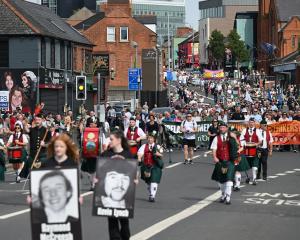
The bike has merits. It is an excuse to wear elastic pants. And propelling it burns carbohydrates, not hydrocarbons, so doubtless the bicyclist is saving Tuvalu and the polar bears. It’s not the bicycle that worries me — it’s the bicyclist. Too many cyclists exude a grating moral superiority. It’s part smug faith in the rectitude of physical exercise — but it’s also belief the bicycle is ethically superior transport. (Something that clocks 50km on three Weet-Bix, must rate high on the virtue scale).
Around Arrowtown grey pedal power is ballooning, and the injury toll among people who should know better, is disturbing. My friend the cheesemaker recently hit a rabbit hole while cycling down to his letter box for the newspaper. (It was the ODT, so I hope it was worth somersaulting the handlebars). Other cycling pensioners hobble on walking sticks, and have arms in slings at bridge. An otherwise delicate lady sports a Joseph Parker shiner.
To cap all this, the Duchess, still recovering from gravel rash, has bought an electric bicycle. This raises the ante uncomfortably, because Wit’s End is now under pressure to similarly invest.I worry that the electric bike is merely a fad. Is it the way of the future, or will it pass into oblivion, like the once mighty tricycle? Few realise the tricycle nearly won the battle for the hearts of pedal people. The early bicycles were considered louche. They were ridden by 1800s dandies and daredevils, and respectable people were reluctant to climb aboard.
But in 1881 this suddenly changed. Queen Victoria, the arbiter of the Empire’s taste, was taking a carriage ride from her holiday castle on the Isle of Wight, when she found the royal picnic overtaken by a whirring vision in petticoats and spokes.
Servants were despatched to investigate whether the phenomenon was human. They discovered the daughter of the local bicycle merchant had been out trialling its newest product — a tricycle built by one James Starley. Taken by the tricycle, Her Majesty immediately ordered a brace, and required the pair be personally delivered by this Starley chap. He obliged, and also gave her young Prince Leopold trike lessons on the palace lawn. (Leo was only 27).
There is no concrete evidence Queen Victoria herself became an avid tricyclist — her waistline was now approaching 50 inches — but her trike purchase instantly changed the cycling landscape. If the Queen owned a tricycle, then it was not only socially acceptable, but the height of fashion. Starley spotted profits (being in trade he knew no better) and branded his trike The Royal Salvo. And society went mad on trikes. Lord Albermarle, Master of the Queen’s Horse, was soon writing that all crowned heads of state owned fleets of tricycles, and indeed, he’d seen a photo of a maharajah and his court, all perched on their trikes.
A tricyclists’ union was established to distinguish its members from mere bicyclists "who are a disgrace to the pastime, while tricycling includes princes, princess, dukes, earls etc." Bicyclist oafs, they thought, should be banned from public parks.
The factions wore different outfits — and if you think this sounds rather like the 1960s Mods versus Rockers wars, with motor scooters (mods in towncoats) versus motorbikes (rockers in leather jackets), you’re right.I’m not sure how the bike triumphed over trike, but its victory was conclusive. By 1896 it had changed society so noticeably, the suffragette Susan B. Anthony wrote: "I think it (the bicycle) has done more to emancipate woman than anything in the world. I stand and rejoice each time I see a woman ride by."
The Bicycle in Wartime claims the bike became militarily important. The book rejoices that British attacks on Boer positions during the South African War usually included one or two bikes — noble beasts who ate little hay, and rarely got sore feet.
I struggle to imagine Tennyson’s poem re-penned as The Charge of the Bike Brigade. Nevertheless it is a fact that our country raised a bicycle battalion, and in 1917 despatched the New Zealand Cyclists Corps to the Western Front. (You can be sure that behind the 300 proud cyclists being inspected by Prime Minister Massey is a parade sergeant about to bellow: "One, two, three, MOUNT!")
For all this, I remain unconvinced about the bicycle. This July the Duchess will ride the Danube trail on an electric bike. I may not be with her. Perhaps a riverboat, with my feet up on the rail and a waiter serving coffee, would be more the ticket.
- John Lapsley is an Arrowtown writer.











